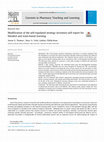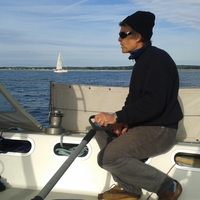Papers by Lindsey Childs-Kean

Currents in Pharmacy Teaching and Learning, 2020
Introduction: One of the primary missions of pharmacy education is to produce graduates with
the ... more Introduction: One of the primary missions of pharmacy education is to produce graduates with
the foundations to develop into expert practitioners through continuous learning and reflection
upon traditional and clinical experiences. This reflection process and the use of effective strategies to meet specific learning goals can be considered a form of self-regulated learning (SRL).
The following study validates an inventory to assess SRL strategies in blended and team-based
learning (TBL) environments.
Methods: A SRL strategy inventory was developed based upon the Self-Regulated Strategies
Inventory-Self-Report (SRSI-SR) and new items designed for blended and TBL environments.
Sixteen new items focused on leveraging the team to learn content, the use and misuse of video
lectures and slides, and interaction with social media and the learning management system. Two
hundred and thirty doctor of pharmacy students in the third professional year participated in the
study. Twenty-eight items from the SRSI-SR and 16 new items were examined through a principal
components analysis (PCA).
Results: The PCA indicated three distinct components; managing learning environment, maladaptive learning strategies, and seeking and learning information. The total inventory accounted
for 46.36% of the score. Maladaptive learning strategies scores were moderately predictive of
poor academic achievement in didactic coursework.
Conclusions: The following study demonstrates the importance of reexamination and adaptation
of educational inventories such as the SRSI-SR. This study provides specific insight into what
maladaptive strategies may be limiting underperforming students from achieving greater success
and mastery in the didactic curriculum.








Uploads
Papers by Lindsey Childs-Kean
the foundations to develop into expert practitioners through continuous learning and reflection
upon traditional and clinical experiences. This reflection process and the use of effective strategies to meet specific learning goals can be considered a form of self-regulated learning (SRL).
The following study validates an inventory to assess SRL strategies in blended and team-based
learning (TBL) environments.
Methods: A SRL strategy inventory was developed based upon the Self-Regulated Strategies
Inventory-Self-Report (SRSI-SR) and new items designed for blended and TBL environments.
Sixteen new items focused on leveraging the team to learn content, the use and misuse of video
lectures and slides, and interaction with social media and the learning management system. Two
hundred and thirty doctor of pharmacy students in the third professional year participated in the
study. Twenty-eight items from the SRSI-SR and 16 new items were examined through a principal
components analysis (PCA).
Results: The PCA indicated three distinct components; managing learning environment, maladaptive learning strategies, and seeking and learning information. The total inventory accounted
for 46.36% of the score. Maladaptive learning strategies scores were moderately predictive of
poor academic achievement in didactic coursework.
Conclusions: The following study demonstrates the importance of reexamination and adaptation
of educational inventories such as the SRSI-SR. This study provides specific insight into what
maladaptive strategies may be limiting underperforming students from achieving greater success
and mastery in the didactic curriculum.
the foundations to develop into expert practitioners through continuous learning and reflection
upon traditional and clinical experiences. This reflection process and the use of effective strategies to meet specific learning goals can be considered a form of self-regulated learning (SRL).
The following study validates an inventory to assess SRL strategies in blended and team-based
learning (TBL) environments.
Methods: A SRL strategy inventory was developed based upon the Self-Regulated Strategies
Inventory-Self-Report (SRSI-SR) and new items designed for blended and TBL environments.
Sixteen new items focused on leveraging the team to learn content, the use and misuse of video
lectures and slides, and interaction with social media and the learning management system. Two
hundred and thirty doctor of pharmacy students in the third professional year participated in the
study. Twenty-eight items from the SRSI-SR and 16 new items were examined through a principal
components analysis (PCA).
Results: The PCA indicated three distinct components; managing learning environment, maladaptive learning strategies, and seeking and learning information. The total inventory accounted
for 46.36% of the score. Maladaptive learning strategies scores were moderately predictive of
poor academic achievement in didactic coursework.
Conclusions: The following study demonstrates the importance of reexamination and adaptation
of educational inventories such as the SRSI-SR. This study provides specific insight into what
maladaptive strategies may be limiting underperforming students from achieving greater success
and mastery in the didactic curriculum.